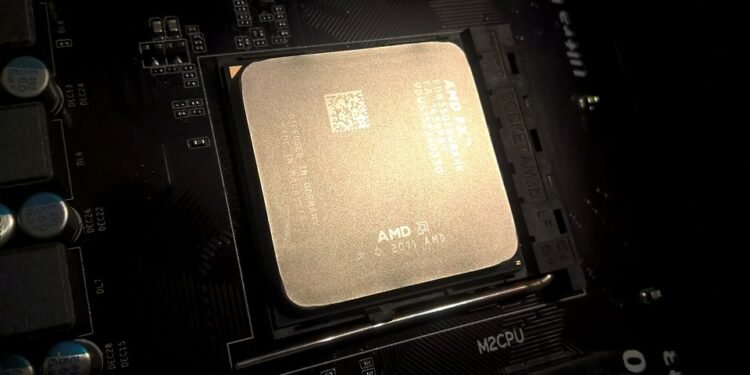AMD Unveils Groundbreaking Chip Technologies at Computex 2024
In a flurry of excitement surrounding AI advancements at Computex 2024 in Taiwan, AMD took center stage with a plethora of new chip technologies poised to revolutionize AI-powered computing across various sectors. From client edge devices to gaming desktops, workstations, and data centers, AMD showcased a comprehensive lineup designed to reshape the technological landscape. Here is an overview of their latest innovations.
Ryzen AI 300 Series: Revolutionizing Thin and Light Laptop Designs
AMD introduced the Ryzen AI 300 Series, a new generation of Strix Point Ryzen laptop processors tailored to handle AI workloads, content creation, and productivity in sleek and lightweight laptop models. Equipped with a cutting-edge 50 TOPS NPU, this series not only redefines AMD’s mobile chips but also continues the legacy of high-performance with the “HX” suffix denoting top-tier capabilities.
The Ryzen AI 300 Series processors leverage AMD’s XDNA 2 NPU architecture, delivering an impressive 50 TOPS of AI processing power. Based on Xilinx FPGA technology, these processors exceed the Copilot+ AI PC standards, boasting a 3X performance increase compared to AMD’s previous-generation mobile CPUs. Built on the Zen 5 and Zen 5c CPU architectures, these mobile CPUs feature 10 or 12 high-performance CPU cores, supporting 20 and 24 threads, respectively, along with up to 50% more on-chip L3 cache memory compared to their predecessors.
The performance comparison of devices powered by the Ryzen AI 300 Series against competitors like Intel Meteor Lake and Qualcomm Snapdragon X Elite will be eagerly anticipated. AMD’s claim of superiority across various tasks, including AI-enhanced productivity, multitasking, and graphics, sets the stage for a compelling battle in the market. Battery life will also play a crucial role in the final assessment, with more insights expected upon the product’s launch in July.
Zen 5 Based Ryzen 9000 Desktop Processors: Setting New Standards for Computing
Under the codename “Granite Ridge,” AMD revealed the latest Zen 5 architecture-based Ryzen 9000 Series processors for desktops. Featuring a new CPU core architecture with enhanced branch prediction, wider data pipelines, and improved parallelism, these chips promise significant gains in AI performance and AVX512 throughput for demanding applications such as scientific simulations, financial analytics, machine learning, and 3D modeling.
The Ryzen 9000 Series processors are expected to deliver an average 16% IPC uplift over their Zen 4-based predecessors for PCs, with even more substantial improvements of up to 23% in gaming, 3D rendering, and content creation tasks. Lightly threaded workloads like web browsing will also benefit from a 15% boost, highlighting the Zen 5 architecture’s prowess in single-threaded operations. These processors will be compatible with current AMD AM5 motherboards, while new X870/X870e motherboard chipsets with USB 4.0 and PCI 5.0 support will be introduced with the launch.
With core counts ranging from 6 to 16 cores and varying thread configurations, the Ryzen 9000 Series offers a diverse lineup catering to different user needs. The flagship Ryzen 9 9950X with 16 cores is expected to deliver exceptional performance, setting the stage for future advancements like the speculated 3D V-Cache enabled Ryzen 9 9950X3D. The desktop processors are scheduled to hit the market in July alongside other AMD innovations.
AMD’s Foray Into Data Center Solutions
Not content with consumer devices, AMD also unveiled its Zen 5-based Epyc data center CPUs, codenamed “Turin.” Featuring a 192-core, 384-thread design, these processors aim to increase core density per socket to compete fiercely in the data center arena. The new Zen 5C architecture in Turin promises enhanced multi-core throughput and multithreaded performance by packing sixteen cores into a single Core Chiplet Die.
Expected to launch in the second half of the year, the Epyc Turing processors are poised to challenge Intel’s 5th Gen Xeon 8592+ chips in two-socket server configurations, with a particular focus on AI throughput performance. The upcoming release of Intel’s Granite Rapids Xeon 6 products with up to 128 Performance Cores later in Q3 will provide an intriguing point of comparison for these cutting-edge processors.
On the AI accelerator front, AMD introduced the MI325X as a successor to the MI300X GPU accelerator, highlighting its significant market potential and rapid adoption. Based on the AMD CDNA 3 GPU architecture, the MI325X boasts 288GB of HBM3 memory for superior bandwidth and improved Large Language Model throughput. Amidst the growing demand for AI solutions, these developments position AMD as a key player in the data center GPU segment, with a roadmap that includes upcoming releases like the CDNA 4 MI350 in 2025 and CDNA 6 in 2026.
Lastly, AMD also refreshed its Radeon Pro W7900 Series workstation GPUs, introducing a more compact and powerful Radeon Pro W7900 Dual Slot card with 48GB of GDDR6 ECC memory. Priced competitively at $3,499, this GPU promises a 52% performance increase per dollar over rival offerings, making it an attractive option for professional users engaged in AI and 3D rendering tasks.
Overall, AMD’s diverse portfolio showcased at Computex 2024 promises significant advancements across mobile, desktop, and data center segments. With a focus on AI processing capabilities led by Zen 5 architecture and the innovative XDNA2 NPU, AMD is primed to lead the charge in the competitive tech landscape. Stay tuned for in-depth analyses and performance evaluations as these groundbreaking products hit the market, and join us at HotTech to track the exciting developments in the world of computing.







